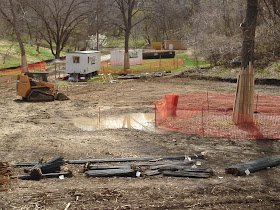There are two activities underway in the hills of Hummel Park which are having a negative impact on its unique forest setting.

Example of the ground disturbance associated with creating a frisbee golf course.
|
Prominent in this situation is an effort to create a frisbee golf course.
This effort - as noted in October 2009 - was supposedly ended, but during a bird survey a few days ago, two guys were moving things around in the woods to establish the course.
"The city wants us to get this done," they said when asked about what they were doing.
The course is meant to increase visitation to the park.
It is obviously changing the nature of the forest.
Corridors through the woods are being established to provide an open "lane" for throwing a frisbee. Deadfall is being moved to indicate the lane to the participants can have a readily apparent route.
Add in the land clearing for the "throw pads" which have included removal of vegetation and moving dirt around by mechanical means, and creating "artificial piles" of fallen tree limbs.
|
Additional examples of ground disturbance caused by guys installing the golf course.
|

|

|
There were options present by two years ago to perchance reduce the impact on the woods, but apparently those suggestions were ignored. In the past few days, requests to city of Omaha officials for further information have been completely ignored.
Nature Center Construction
Also during this time in April, it became readily apparent that work associated with the construction of the Hummel Park Nature Center, was also impacting the park woods.
Obviously apparent is a corridor through the woods, southward from the pending building. This change has removed all of the vegetation to create what looks like a path through the trees.
Apparently, this is the corridor for a new water line. There will not be a ditch dug but it will be buried by "careful construction" and the site seeded to typical vegetation.
It was quite fine to be on the site while a city official and the constructors discussed the project, as they all huddled in a close group.
The city man said plants typical of the area would be planted, mentioning grass as the current option.
How does grass replace woodland vegetation? After a few other comments, the official of the Omaha Parks and Recreation Department said he needed to talk with the constructors and that my comments should occur later as they were all "busy."
|
The corridor created through the woods to allow installing a new water line. the Omaha Parks and Recreation man at the site said grass would be planted here.

|
Construction site for the new Hummel Park Nature Center.

|
|
Talking about the project at the site.

|
Closure barricade preventing access to the parks picnic grounds. One reason for installing the frisbee golf course was to increase usage of the park. It is not possible to readily use the park if one of its primary public use areas is not accessible. These four pictures taken April 20, 2011.

|
Hummel Park has been one of the most unique settings in the Omaha park system, but its value is changing because of disregard for its natural value, with more emphasis being given to increased usage by people ignorant of the actual natural importance of the sites features.
Cutting through the woods, creating throw pads for frisbee golfers, destroying native vegetation, not seeding disturbed sites to suitable woodland species, or even expecting that natural regrowth might suffice to get plant growth on sites where the woodland where dramatically altered does not indicate that there was any concern for the unique natural values of this woodland.

























